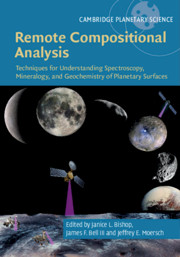 Remote Compositional Analysis
Remote Compositional Analysis Book contents
- Remote Compositional Analysis
- Cambridge Planetary Science
- Remote Compositional Analysis
- Copyright page
- Contents
- Contributors
- Foreword
- Preface
- Acknowledgments
- Part I Theory of Remote Compositional Analysis Techniques and Laboratory Measurements
- Part II Terrestrial Field and Airborne Applications
- Part III Analysis Methods
- Part IV Applications to Planetary Surfaces
- 17 Spectral Analyses of Mercury
- 18 Compositional Analysis of the Moon in the Visible and Near-Infrared Regions
- 19 Spectral Analyses of Asteroids
- 20 Visible and Near-Infrared Spectral Analyses of Asteroids and Comets from Dawn and Rosetta
- 21 Spectral Analyses of Saturn’s Moons Using the Cassini Visual Infrared Mapping Spectrometer
- 22 Spectroscopy of Pluto and Its Satellites
- 23 Visible to Short-Wave Infrared Spectral Analyses of Mars from Orbit Using CRISM and OMEGA
- 24 Thermal Infrared Spectral Analyses of Mars from Orbit Using the Thermal Emission Spectrometer and Thermal Emission Imaging System
- 25 Thermal Infrared Remote Sensing of Mars from Rovers Using the Miniature Thermal Emission Spectrometer
- 26 Compositional and Mineralogic Analyses of Mars Using Multispectral Imaging on the Mars Exploration Rover, Phoenix, and Mars Science Laboratory Missions
- 27 Mössbauer Spectroscopy at Gusev Crater and Meridiani Planum
- 28 Elemental Analyses of Mars from Rovers Using the Alpha-Particle X-Ray Spectrometer
- 29 Elemental Analyses of Mars from Rovers with Laser-Induced Breakdown Spectroscopy by ChemCam and SuperCam
- 30 Neutron, Gamma-Ray, and X-Ray Spectroscopy of Planetary Bodies
- 31 Radar Remote Sensing of Planetary Bodies
- Index
- References
22 - Spectroscopy of Pluto and Its Satellites
from Part IV - Applications to Planetary Surfaces
Published online by Cambridge University Press: 15 November 2019
- Remote Compositional Analysis
- Cambridge Planetary Science
- Remote Compositional Analysis
- Copyright page
- Contents
- Contributors
- Foreword
- Preface
- Acknowledgments
- Part I Theory of Remote Compositional Analysis Techniques and Laboratory Measurements
- Part II Terrestrial Field and Airborne Applications
- Part III Analysis Methods
- Part IV Applications to Planetary Surfaces
- 17 Spectral Analyses of Mercury
- 18 Compositional Analysis of the Moon in the Visible and Near-Infrared Regions
- 19 Spectral Analyses of Asteroids
- 20 Visible and Near-Infrared Spectral Analyses of Asteroids and Comets from Dawn and Rosetta
- 21 Spectral Analyses of Saturn’s Moons Using the Cassini Visual Infrared Mapping Spectrometer
- 22 Spectroscopy of Pluto and Its Satellites
- 23 Visible to Short-Wave Infrared Spectral Analyses of Mars from Orbit Using CRISM and OMEGA
- 24 Thermal Infrared Spectral Analyses of Mars from Orbit Using the Thermal Emission Spectrometer and Thermal Emission Imaging System
- 25 Thermal Infrared Remote Sensing of Mars from Rovers Using the Miniature Thermal Emission Spectrometer
- 26 Compositional and Mineralogic Analyses of Mars Using Multispectral Imaging on the Mars Exploration Rover, Phoenix, and Mars Science Laboratory Missions
- 27 Mössbauer Spectroscopy at Gusev Crater and Meridiani Planum
- 28 Elemental Analyses of Mars from Rovers Using the Alpha-Particle X-Ray Spectrometer
- 29 Elemental Analyses of Mars from Rovers with Laser-Induced Breakdown Spectroscopy by ChemCam and SuperCam
- 30 Neutron, Gamma-Ray, and X-Ray Spectroscopy of Planetary Bodies
- 31 Radar Remote Sensing of Planetary Bodies
- Index
- References
Summary
The near-infrared reflectance spectra of Pluto and its satellites are rich with diagnostic absorption bands of ices of CH4, N2, CO, H2O, and an incompletely identified ammonia-bearing molecule. Following years of investigation of the spectra of Pluto and Charon with ground-based telescopes, NASA’s New Horizons spacecraft obtained spectral maps of these bodies and three small satellites on its passage through the system on July 14, 2015, showing the distribution of these ices, as well as a colored, non-ice component. Spectral modeling mapped the distribution of the various ices and showed their abundance and mixing details in relationship to regions of differing surface elevation, albedo, and geologic structure. Additionally, owing to their greatly different degrees of volatility, the ices of Pluto are distributed in patterns responsive to Pluto’s climatic changes on both short and long terms. The surface of Charon is dominated spectrally by H2O ice with one or more ammoniated compounds, and three of the four very small satellites show both H2O ice and the ammonia signature.
Keywords
- Type
- Chapter
- Information
- Remote Compositional AnalysisTechniques for Understanding Spectroscopy, Mineralogy, and Geochemistry of Planetary Surfaces, pp. 442 - 452Publisher: Cambridge University PressPrint publication year: 2019


